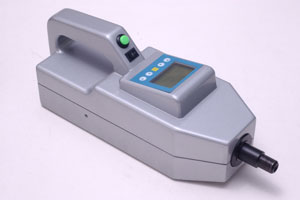 With supports from the “Innovation Project” of the CAS, Science and Technology Commission of Shanghai Municipality, and national “863” program, Shanghai Institute of Microsystem and Information Technology, CAS, has developed the ultra sensitive explosive detector with detection sensitivity higher than the traditional fluorescence technology, through utilizing the fluorescence multiplication effect of the organic semiconductor polymer and combining the resonance fluorescence detection technology of the Integrated Optics. It can sense the odor of the explosive like an explosive dog, so as to identify the position of the hidden explosive. The 1kg weight detector is powered by the lithium ion rechargeable battery, with non-contact sampling. In the SCO Summit in June 2006, the detector was deployed by the Shanghai Public Security Bureau in the Lujiazui Station of Shanghai Railway Line 2 for explosive detection. The detector competed with the explosive dog on site in the security drill conducted prior to the Summit congregation, when the detector was able to sense the TNT odor that even the explosive dog wasn’t able to tell, and give the alarm. It showed that the detector has even stronger explosive detecting capacity than the explosive dog.
With supports from the “Innovation Project” of the CAS, Science and Technology Commission of Shanghai Municipality, and national “863” program, Shanghai Institute of Microsystem and Information Technology, CAS, has developed the ultra sensitive explosive detector with detection sensitivity higher than the traditional fluorescence technology, through utilizing the fluorescence multiplication effect of the organic semiconductor polymer and combining the resonance fluorescence detection technology of the Integrated Optics. It can sense the odor of the explosive like an explosive dog, so as to identify the position of the hidden explosive. The 1kg weight detector is powered by the lithium ion rechargeable battery, with non-contact sampling. In the SCO Summit in June 2006, the detector was deployed by the Shanghai Public Security Bureau in the Lujiazui Station of Shanghai Railway Line 2 for explosive detection. The detector competed with the explosive dog on site in the security drill conducted prior to the Summit congregation, when the detector was able to sense the TNT odor that even the explosive dog wasn’t able to tell, and give the alarm. It showed that the detector has even stronger explosive detecting capacity than the explosive dog.
The detector passed the new product modeling test conducted by the Ministry of Public Security in February 2007. The detection result showed that the detector can detect TNT, ammonia dynamite, explosive B, Octogen, emulsion explosive, plastic explosive, ammonium nitrate explosive, PW0 explosive, and PW30 explosive, with the lower limit of the detection reaching the ppt level (10-14g/ml). All testing indexes including mechanical and electrical properties, etc. meet national standards.
 With supports from the “Innovation Project” of the CAS, Science and Technology Commission of Shanghai Municipality, and national “863” program, Shanghai Institute of Microsystem and Information Technology, CAS, has developed the ultra sensitive explosive detector with detection sensitivity higher than the traditional fluorescence technology, through utilizing the fluorescence multiplication effect of the organic semiconductor polymer and combining the resonance fluorescence detection technology of the Integrated Optics. It can sense the odor of the explosive like an explosive dog, so as to identify the position of the hidden explosive. The 1kg weight detector is powered by the lithium ion rechargeable battery, with non-contact sampling. In the SCO Summit in June 2006, the detector was deployed by the Shanghai Public Security Bureau in the Lujiazui Station of Shanghai Railway Line 2 for explosive detection. The detector competed with the explosive dog on site in the security drill conducted prior to the Summit congregation, when the detector was able to sense the TNT odor that even the explosive dog wasn’t able to tell, and give the alarm. It showed that the detector has even stronger explosive detecting capacity than the explosive dog.
With supports from the “Innovation Project” of the CAS, Science and Technology Commission of Shanghai Municipality, and national “863” program, Shanghai Institute of Microsystem and Information Technology, CAS, has developed the ultra sensitive explosive detector with detection sensitivity higher than the traditional fluorescence technology, through utilizing the fluorescence multiplication effect of the organic semiconductor polymer and combining the resonance fluorescence detection technology of the Integrated Optics. It can sense the odor of the explosive like an explosive dog, so as to identify the position of the hidden explosive. The 1kg weight detector is powered by the lithium ion rechargeable battery, with non-contact sampling. In the SCO Summit in June 2006, the detector was deployed by the Shanghai Public Security Bureau in the Lujiazui Station of Shanghai Railway Line 2 for explosive detection. The detector competed with the explosive dog on site in the security drill conducted prior to the Summit congregation, when the detector was able to sense the TNT odor that even the explosive dog wasn’t able to tell, and give the alarm. It showed that the detector has even stronger explosive detecting capacity than the explosive dog.